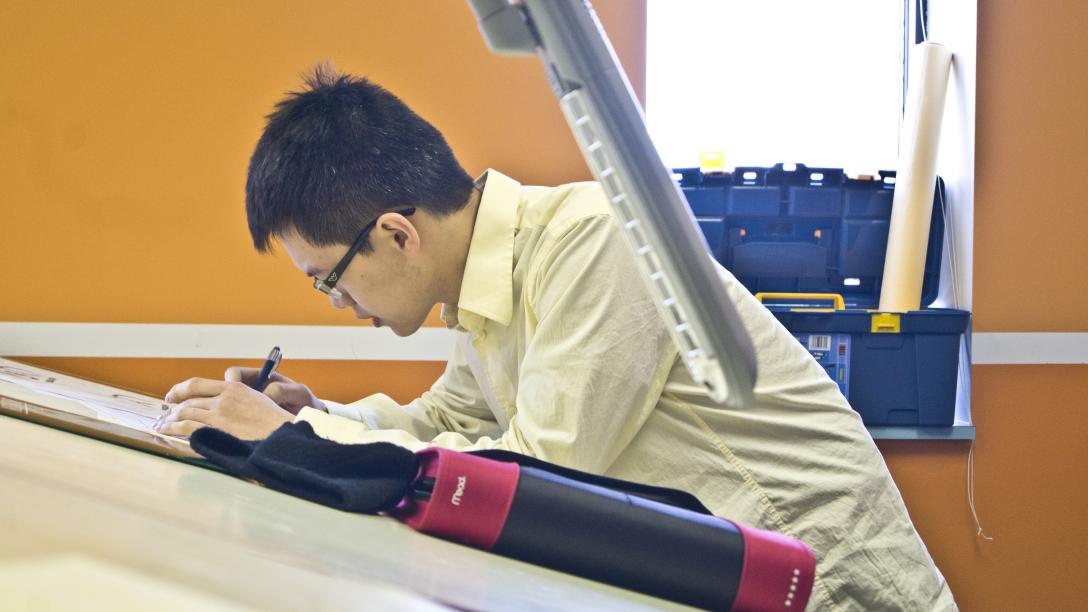Interior Architecture and Design
If creating inspiring and purposeful spaces where people live, work, and play is your passion, Mercyhurst’s Interior Architecture and Design program is the path for you. Pursuing a career in interior design will allow you to let your creativity flow while researching and implementing safe structures, innovative spatial planning, and purposeful beauty in each of your building layouts. It will be your responsibility to create environments that are both aesthetic and technologically sound.
As an interior designer, the sky is the limit to what you can create. Your future career can lead you to design structures that serve the greater community led by innovation and technology. Professional interior designers must keep aesthetics, environmental design, and community impact in mind as they work with the technical aspects of constructing their ideas.
Our Interior Architecture and Design program provides students not only a strong foundation in applied art and design, but a variety of related fields including management, sustainability, history, and ethics. All students are supervised through an internship experience to build their portfolio in a real-world professional setting. Students receive hands-on experiences with community building and design projects and are networked with professionals from the design world.
Fast Facts
- 100% of design faculty are practitioners with real-world experience.
- Interior Architecture and Design students enjoy 24/7 exclusive use of the IAD Studio spaces. Studio spaces include a drafting and design studio, student computers with access to the latest technology, materials and resources library, and large format printing.
- Students supported with resources to sit for the Leadership in Energy and Environmental Design (LEED) exam.
- Student access to free use of the latest software programs: AutoCAD, Revit, SketchUp, Lumion, and Adobe Creative Suites (Photoshop, InDesign, and Illustrator). Students involved in networking with professionals from the tristate design community.
- 100% pass rate of the National Council for Interior Design Qualification (NCIDQ) exam after graduation.
- 98% placement rate in professional jobs or grad school.
- Alums employed by the leading design firms and corporations throughout the nation, including the number one architecture and design firm in the world.
- Internships and in-class projects provide students with real-world experience with real clients.
Mission
The program of Interior Architecture and Design establishes its mission as the promotion of the intellectual, emotional, social, physical, and spiritual growth of the student as an effective citizen through liberal and professional education. Therefore, the programs prepare the student not only for a career, but also for life. Faculty and students are challenged to integrate social responsibility with career competence and a commitment to human values.
The faculty believes that:
- Education is a life-long process of guided and purposeful activity, directed toward the development of the individual according to his/her needs, abilities, interests, and potential.
- Education is not merely a passive acquisition of knowledge, but rather the meaningful interpretation of that knowledge, and an understanding capable of producing intelligent decisions and actions.
- Learning is a change in behavior brought about through experience.
- The identification of learning outcomes is done cooperatively by the student and teacher.
- Self-discovery, self-growth, and self-expression are best achieved in a relaxed and open environment which remains sensitive and adaptive to the student’s needs and abilities.
- The teacher is a facilitator of that self-discovery and self-growth.
- They further believe that learning in the professional environment, where students interact with clients and professionals and can apply theoretical principles, is very effective in developing professional proficiency as well as classroom/studio-oriented education.
The meaning of this philosophy for Interior Architecture and Design education is that the curriculum should provide a judicious balance of learning experience with essential knowledge and understanding to be gained in the physical, behavioral and social sciences, humanities, professional sciences and communicative sciences. As potential translators of architectural and interior science, the students need the science (knowledge) and the art (skill) inherent in the interior design profession. Only when they have cultivated moral values can they translate this science and art into action, in a wide variety of settings, with sensitivity, self-reliance, social concern, and genuine compassion for others.
- Art 100 Drawing I (3 credits)
- Art 122 or 123 Art History (3 credits)
- Art 125 2-Dimensional Design (3 credits)
- Art 126 3-Dimensional Design (3 credits)
- Basic Level 2-D Studio (3 credits)
- Basic Level 3-D Studio (3 credits)
- Art Electives (2) (3 credits)
- COM 101: Communication in Society
- COM 102: Interpersonal Communication
- COM 260: Introduction to Social Media
- Course Choices (9 credits)
- ART 128 Basic Computer Design 3 credits
- ART 220 Typographic Foundations 3 credits
- ART 221 Digital Imagery 3 credits
- Four (4) Approved Art and Graphic Design Elective
A Communication minor complements various majors and allows students to refine their professional and creative skills further. The minor includes six courses, consisting of 18 credits.
Required Courses (9 credits)
Students must take three additional courses within the Communication Department, two of which must be 300-level or higher.
Minors (unless permitted by the Department Chair) are not able to take COM 390: Professional Development or COM 473/475: Internship.
Learning Outcomes
- Have a global view of their responsibility as stewards of natural resources and the impact of design decisions within the parameters of ecological, socio-economic, and cultural contexts
- Understand and address human needs (social, economic, political, psychological, and physiological) in the applied practice of interior design
- Respond with creative problem-solving by exploring complex problems and generating creative solutions that optimize the human experience within the interior environment
- Engage in multi-disciplinary collaboration
- Effectively communicate visually, orally, and in the written word using appropriate techniques and technologies
- Understand and adopt accepted standards of business and organizational practices with commitment to the highest levels of professional standards and ethics, as well as demonstrate a willingness to advance not only themselves but the profession of interior design as a whole
- Develop a strong sense of the theoretical basis of art and design, as well as use historical/cultural context and precedence to enhance design decisions
Career Outcomes
During your four years of study, you’ll develop a portfolio to demonstrate your talents for prospective employers after graduation. Our students get hands-on design experience working on projects at local retail, restaurant, healthcare and institutional businesses and residences. You’ll also have the opportunity to compete in several different design competitions on the regional, state, and national level. Our mentoring program brings experienced professionals from architecture and design firms, materials manufacturers, and national design organizations into the classroom, so that beginning freshman year, you’ll be engaging with potential employers and networking for your future.
With excellent career and academic advising and an extensive alumni network at top employers around the world, our Interior Architecture and Design graduates pursue a wide range of careers. Our graduates are working in industries including:
- Facilities planning
- Product design
- Healthcare design
- Residential design
- Hospitality design
- Sustainable design
- Kitchen and bath design
- Visual merchandising
- ASID (American Society of Interior Designer)—The oldest interior design professional organization exposes students to regional and national level networking in both commercial and residential design.
- IIDA (International Interior Design Association)—A consortium of design organizations that supports students in business and commercial design on an international level.
- IAD Club (Interior Architecture and Design)—This Mercyhurst student organization supports career development of all design students and promotes work and fun in the student’s career path!
- National Council for Interior Design Qualification (NCIDQ) Exam — This professional exam is the ultimate evidence of professional achievement and is one component for licensing in states that have interior design license requirements. The exam requires two components: education and experience. Mercyhurst’s IAD program provides students with the educational component, and the experience component requires students to earn hours of employment post-graduation. This national exam includes three parts. Students are eligible to sit for part one beginning their senior year. Eligibility for the remaining two parts requires employment in the field after graduation.
- Leadership in Energy and Environmental Design (LEED) Green Associate Exam — All students are eligible for and are encouraged to take this exam following a self-study component. Access and resources for study and exam preparation are provided.
This program may fulfill a portion of the requirements leading to licensure within this field. Please visit the State Authorization webpage to review the requirements for licensure by state or program.
Mercyhurst Interior Architecture and Design students find internships and employment at leading design firms and corporations including:
| Gensler—The No. 1 Architecture and Design firm in the world! | ULTA Beauty | U.S. State Department | U.S. Pentagon |
| Starbucks | FEMA | Dick’s Sporting Goods | McDonald's |
| Nike | Hallmark | Michael Kors | UPMC |
| National City Bank | Erie Insurance Group | Ethan Allen | Marriott Hotels |
| Studio 3877 | 3form | Arhaus Furniture | Anthropologie |
Our Interior Architecture and Design students enjoy memberships in and access to the following professional organizations that engage them with design professionals and career advice and networking on the national level and in the tri-state area:
The Interior Architecture and Design curriculum is tailored to national interior design educational and sustainable design standards, providing students of design with the opportunity to seek success in the following professional exams:
In the spring of each academic year, the Mercyhurst University interior architecture and design department hosts its annual exhibition of projects . These projects are the culmination of 30 weeks of research and preparation over three terms. The exhibit is displayed in the Cummings Art Gallery on campus and is open to the public. An opening reception initiates the exhibition and invited guests include faculty, friends, family, professional designers and architects, and prospective employers.

Darren Trautman
Program Director, Interior Architecture & Design; Instructor
Office: 121 Hirt
Meet the Faculty
Art, Design, and Communication










